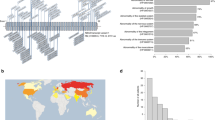Abstract
Neuroblastoma (NB) is a childhood malignancy originating from neural crest cells, which seldom occurs in association with other neurocristopathies. Owing to the rarity of familial NB cases, only a few linkage data are available and no mutations in candidate genes have been demonstrated up till now. Germline mutations in a small proportion of NB patients have been recently reported in the paired-like homeobox 2B (PHOX2B) gene, suggesting its role in NB predisposition. On the basis of this indication, we screened three Italian families with recurrence of NB and one family with occurrence of ganglioneuroblastoma and isolated Hirschsprung disease for PHOX2B defects. Our analysis did not show any mutation, excluding PHOX2B as the NB susceptibility gene in the families we analysed. Our findings combined with those derived from other PHOX2B mutation screenings and from genome-wide linkage analysis support a remarkable genetic heterogeneity of NB and suggest an oligogenic model of disease transmission. Furthermore, as PHOX2B mutations were mainly observed in some NB families with multifocal and syndromic NB, features that are missing in the families we have studied, we suggest they represent second-site modifications responsible for a specific phenotype rather than causal mutations of a major locus.
This is a preview of subscription content, access via your institution
Access options
Subscribe to this journal
Receive 50 print issues and online access
$259.00 per year
only $5.18 per issue
Buy this article
- Purchase on Springer Link
- Instant access to full article PDF
Prices may be subject to local taxes which are calculated during checkout

Similar content being viewed by others
References
Amiel J, Laudier B, Attie-Bitach T, Trang H, de Pontual L, Gener B, Trochet D, Etchevers H, Ray P, Simonneau M, Vekemans M, Munnich A, Gaultier C and Lyonnet S . (2003). Nat. Genet., 33, 459–461.
Brodeur GM, Pritchard J, Berthold F, Carlsen NL, Castel V, Castelberry RP, De Bernardi B, Evans AE, Favrot M and Hedborg F . (1993). J. Clin. Oncol., 11, 1466–1477.
Croaker GD, Shi E, Simpson E, Cartmill T and Cass DT . (1998). Arch. Dis. Child, 78, 316–322.
Griseri P, Mishto M, Priolo M, Pesce B, Hamel BCJ, Romeo G, Ravazzolo R and Ceccherini I . (2000). Gene Funct. Dis., 1, 184–188.
Katsanis N . (2004). Hum. Mol. Genet., 13 (Spec. No. 1), R65–R71.
Knudson AG and Strong LC . (1972). Am. J. Hum. Genet., 24, 514–532.
Limpt VV, Schramm A, Lakeman A, Sluis PV, Chan A, Noesel MV, Baas F, Caron H, Eggert A and Versteeg R . (2004). Oncogene, 23, 9280–9288.
Maris JM, Weiss MJ, Mosse Y, Hii G, Guo C, White PS, Hogarty MD, Mirensky T, Brodeur GM, Rebbeck TR, Urbanek M and Shusterman S . (2002). Cancer Res., 62, 6651–6658.
Matera I, Bachetti T, Puppo F, Di Duca M, Morandi F, Casiraghi GM, Cilio MR, Hennekam R, Hofstra R, Schober JG, Ravazzolo R, Ottonello G and Ceccherini I . (2004). J. Med. Genet., 41, 373–380.
Ming JE and Muenke M . (2002). Am. J. Hum. Genet., 71, 1017–1032.
Mosse YP, Laudenslager M, Khazi D, Carlisle AJ, Winter CL, Rappaport E and Maris JM . (2004). Am. J. Hum. Genet., 75, 730–731.
Origone P, Defferrari R, Mazzocco K, Lo Cunsolo C, De Bernardi B and Tonini GP . (2003). Am. J. Med. Genet., 118A, 309–313.
Pattyn A, Morin X, Cremer H, Goridis C and Brunet JF . (1999). Nature, 399, 366–370.
Perri P, Longo L, Cusano R, McConville CM, Rees SA, Devoto M, Conte M, Ferrara GB, Seri M, Romeo G and Tonini GP . (2002a). Oncogene, 21, 8356–8360.
Perri P, Longo L, McConville C, Cusano R, Rees SA, Seri M, Conte M, Romeo G, Devoto M and Tonini GP . (2002b). Ann. NY Acad. Sci., 963, 74–84.
Shimada H, Ambros IM, Dehner LP, Hata J, Joshi VV and Roald B . (1999). Cancer, 86, 349–363.
Tonini GP, Longo L, Coco S and Perri P . (2003). Cancer Lett., 197, 41–45.
Trochet D, Bourdeaut F, Janoueix-Lerosey I, Deville A, De Pontual L, Schleiermacher G, Coze C, Philip N, Frebourg T, Munnich A, Lyonnet S, Delattre O and Amiel J . (2004). Am. J. Hum. Genet., 74, 761–764.
Weese-Mayer DE, Berry-Kravis EM, Zhou L, Maher BS, Silvestri JM, Curran ME and Marazita ML . (2003). Am. J. Med. Genet., 123A, 267–278.
Acknowledgements
We would like to thank the clinicians of Gaslini Children's Hospital-Genoa and Regina Margherita Children's Hospital-Turin for their cooperation to recruit NB families and supply us with clinical information on patients. This study was financed by Fondazione Italiana per la Lotta al Neuroblastoma, Associazione Italiana per la Ricerca sul Cancro (AIRC) and Banco di S Paolo grants. We declare that they have no conflicts of interest.
Author information
Authors and Affiliations
Corresponding author
Rights and permissions
About this article
Cite this article
Perri, P., Bachetti, T., Longo, L. et al. PHOX2B mutations and genetic predisposition to neuroblastoma. Oncogene 24, 3050–3053 (2005). https://doi.org/10.1038/sj.onc.1208532
Received:
Accepted:
Published:
Issue Date:
DOI: https://doi.org/10.1038/sj.onc.1208532
Keywords
This article is cited by
-
Genetic predisposition and chromosome instability in neuroblastoma
Cancer and Metastasis Reviews (2020)
-
The zebrafish as a model for studying neuroblastoma
Cancer Cell International (2016)
-
Knockout mouse models of Hirschsprung’s disease
Pediatric Surgery International (2015)
-
The role of genetic and epigenetic alterations in neuroblastoma disease pathogenesis
Pediatric Surgery International (2013)
-
Genetic basis of Hirschsprung’s disease
Pediatric Surgery International (2009)



